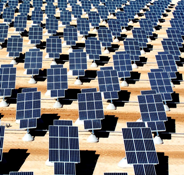 India is sitting on huge untapped solar photovoltaic offgrid opportunities, given its ability to provide energy to hitherto vast untapped remote rural areas, the scope of providing backup power to cell towers and its inherent potential to replace precious fossil fuels.
India is sitting on huge untapped solar photovoltaic offgrid opportunities, given its ability to provide energy to hitherto vast untapped remote rural areas, the scope of providing backup power to cell towers and its inherent potential to replace precious fossil fuels.
"The solar PV offgrid opportunities in India are huge, given the fact that over 400 million people do not have access to grid connected electricity", Sathya Prasad, president, SEMI India (Semiconductor Equipment Materials International) told PTI. The off-grid opportunities are significant, given the cost involved in offgrid applications when compared to huge financial investments to be made to set up grids.
Moreover, specific government incentives to promote off grid applications, rapid expansion of wireless telecom and telecom companies' desire to reduce operating cost for base stations (due to diesel cost and losses in diesel pilferage) are also expected to prompt growth in off-grid opportunities.
The potential of replacing huge usage of kerosene used for lighting rural homes makes off-grid applications desirable.
The examples of off-grid PV applications include remote village electrification, power irrigation pump sets, telecom towers, back up power generation, captive power generation and city, street, billboard and highway lighting.
The government's solar mission envisages off-grid applications reaching 2000 MW by 2022 and deploying 20 million solar lighting systems for rural areas, Prasad said. "However, rapid increase in the market will happen when entrepreneurs and firms tackle unmet needs of the segment and deliver solutions targetted at satisfying the requirements at market sustainable prices", he said.
On funding, he said the current model proposes combination of subsidy and low interest rate loans to promote off grid applications. "It is too early to say if this is adequate to drive the market.
In the long-term, models like PPP, for profit commercial models are expected to drive growth. Some measure similar to cess on coal may be helpful for promoting off grid", he said.
"The India solar market has been growing at approximately 30 per cent CAGR from 2004-2008 and we expect this double digit growth rate in the coming four to five years," Prasad said.
"India's solar/pv module production has crossed more than 1 GW per year in 2009,up from 0.6 in 2005.The photovoltaic solar energy market is emerging and is set for strong growth, he said.
India already has the world's best solar resources and can position itself to be global leader in Solar PV.To meet energy demands, the government has approved the Jawaharlal Nehru National Solar Mission, aimed at generating 20,000 MW by 2022. On the opportunity for India to become a leader in solar PV, Prasad said it would be largely driven by domestic demand both grid and off grid, policy support and continuous striving to replace or reduce fossil fuel consumption.
India is also developing manufacturing prowess in PV cells and modules and several companies are exploring options to include raw material manufacturing a well as looking to deploy the modules they manufacture, he said.
"India has to build on its capabilities in areas like R&D, talent pool, expansion, training to fully exploit opportunities to become a leading producer and consumer of solar/PV", he said. The key challenges facing the growth and development of PV in India include the need for continued cost reduction of systems and end products, he said.
"This can be achieved through increased volumes, manufacturing efficiencies and technology driven cost reduction in material and processes. Also common industry manufacturing standards, streamlined certification and testing can further help drive cost reduction", said Prasad.
There was need for focussed, collaborative and goal driven R&D to help India attain technology and manufacturing leadership in PV. This could be achieved through greater industry-academia collaboration, he opined.
Expanding the PV supply chain, exchange of business,market and technology information through B2B platform comprising exposition, workshops and conferences could help boost it.
"There is need for training and development of human resources to drive industry growth and PV adoption", he said.
Expanding deployment of PV in off-grid applications in addition to building out of large solar/pv utility scale projects was also necessary to drive growth.
On factors that could scale up current business, he said India's solar PV industry had huge potential, given that the country enjoyed an average of 300 sunny days per year.
Solar/pv is now just 0.5 percent of total power consumed and just 10 per cent of renewable energy consumed in the country.
Rising demand for energy driven by GDP growth rate and gap between energy supply and demand, penetration to remote under served areas, availability of low cost reduction of solar/pv, energy security for the nation and growing emphasis on clean tech and renewable energy to combat climate change are set to grow the industry, he said.








 © 2025
© 2025